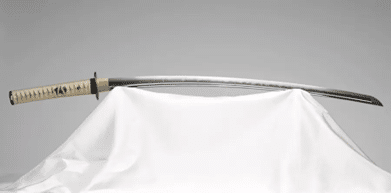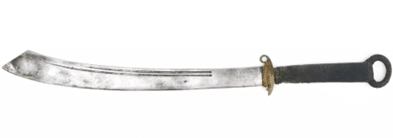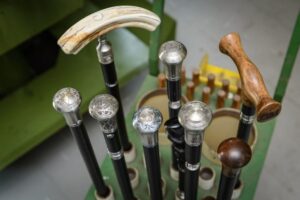The 2nd Amendment: we mostly think about it as firearms, but in the American Revolution, swords were also important weapons. American cavalrymen carried long sabers, frequently as shock troops who charged at great speeds. Infantrymen were often armed with a short sword measuring around 25 inches in length, known as a “hanger” that served as a secondary weapon to the musket. As a result, swords were plentiful when the Constitution was written.
Today, probably no one would choose a sword over a firearm for most self-defense situations they might face, but it is incumbent that we force the opponents of our God-given right of self-defense to defend their entire foolish and naïve would-be bans or limitations on our right. We must demand to own other self-defense weapons, including swords.
You may not have contemplated swords since you were a wee tike running around with a small wooden one playing pirate, so let’s quickly look at some characteristics of today’s long blades. Swords changed over the last several millennia, primarily because the character and conduct of warfare (the type of enemy – such as mounted versus dismounted and what formations they used; tactics; metallurgy; the armor worn by your opponent, and so forth) constantly changes.
Today, the character and conduct of your fight could be combat inside your home, or outside. The guy probably trying to kill you will likely have neither a sword of his own, nor wearing armor, most-likely be a single opponent, or at most a small group, but not part of a large, packed formation such as a Greek phalanx! If outside your domicile, if he has a gun and you don’t, you have a problem – unless you can strike first, while inside the house, you know the terrain which is a huge advantage. But again, this is not an argument to trade in your Browning 12 gauge for a Renaissance-era Zweihänder (two-handed) long sword – not that a blow from the latter won’t disable an attacker, but swinging that bad boy inside and you’ll find out what collateral damage is!
So here are some general types of swords you could own, and you aren’t limited to just one! Just like with firearms, you have to practice, practice, practice: you and two other buddies just can’t saunter out in the back yard one afternoon, swinging your swords expecting to become the Three Musketeers. And these are not wood or dull; they can will cut you if you don’t know what you’re doing.
Slasher. The Japanese Katana (above; sometimes called a Samurai sword in modern culture) is one of the best, if not the best, slashing swords available due to the stability, flexibility, and precision provided by the handle and soft curvature of its single-edge blade. The downside? You’re looking at years to get good with it – which is true for many swords ! – and it’s pretty long for inside-the-house use!
Cutter/Chopper. Cutting strikes are different from slashing, as they look to sever body parts (sword-fighting is bloody; get used to it). The best cutter/choppers have broad, sturdy, blades with a forward center of gravity that focus all of their power on the single-edge blade. A Chinese Dadao (above) is a good choice.
Thruster. While it can slash, the whole point of the thruster is to bury the blade’s point deep into the chest/guts of the other guy. Nothing did that better, for a longer period of time, than the Roman Gladius, the sword of the Roman legion. Blade length is about 20 inches; inside the house is doable, because you aren’t swinging it, you’re stabbing. Remember! Since the blade can be 2.6″ in width, the wounds are often fatal.
Jack of All Trades. The above three types were designed for fighting, but a machete can serve many other purposes, cutting bushes, small trees, ropes, and even digging the ground when necessary, and be a slasher if need be. They love getting dirty.
Stealth. Cane Swords provide you with that crucial 2 seconds of getting it into the fight – because your attacker has probably never encountered one before. But laws concerning them are so nebulous, so often mis-quoted, that while I feel confident that used inside your house you might be OK, outside – well, we must push lawmakers allow them for self-defense anywhere. Cold Steel makes several economic models, while Burger Custom Canes produces ones so exquisite that your kids will fight over it in your Will, and let their siblings have the lake house and your beloved 1966 GTO.
Intimidator. Nope, not Dale Earnhardt. It’s the Khukuri. Think Gurkha. Think “Ayo Gorkhali!” (“Here come the Gorkhas!”) Yes, deterrence will not always work, but if it doesn’t, this bad mama-jama looks like it is going to hurt somebody really bad – because it will. I can’t say enough about Himalayan Imports, that makes these over in Nepal. I own a bunch. Some are 30″ long, but you want one 15-20″ as its easier to control. 5160 Straight Carbon Spring Steel leaf-springs off of large cargo trucks, preferably Mercedes or Saabs, past their operational life, are retooled into blades. The Ang Khola model is almost unbreakable; some can even serve as a prybar. Does what a machete and ax can do. When I bought mine, they provided the name/info of the smith (kami) who forged each; I hope they still do. Even if you never want it as a weapon, you should consider owning one of these.
Throughout history, a quality-made sword spoke of the unique character of its owner; in some cultures, only the bravest could possess one. Be that protector of your own house and family. Find your Excalibur.




